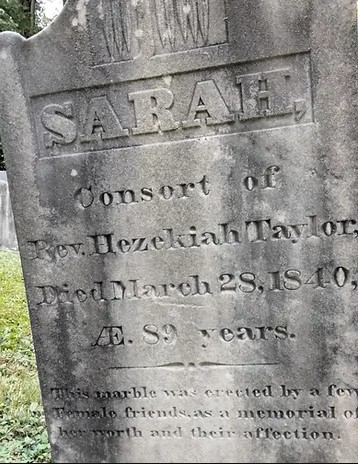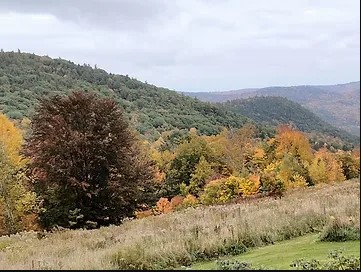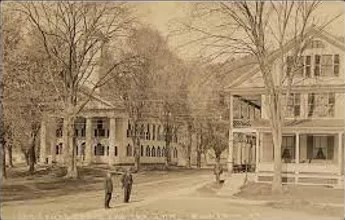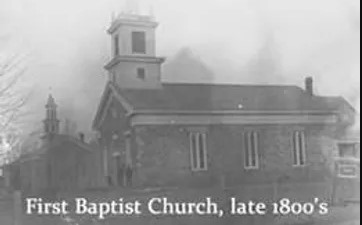
Sarah's Story
In my quest to discover who Sarah, Consort of Reverend Hezekiah Taylor was, I dove into the history of Newfane Hill, which eventually became New Fane and later, Newfane. What a history this tiny town held, nestled in the Green Mountains of Vermont. From the tapestry of Newfane Hill history I was determined to find the thread that was Sarah.
Newfane Hill is actually a small mountain, rather than a hill. It is surrounded by the Hoosak, Greylock, Woodford, Haystack and Stratton mountains to the west, with Mt. Holly in the northwest. Mt. Ascutney, where I skied while living in Reading, is the largest mountain on the landscape

View of surrounding mountains from Stratton Mountain

The village of Newfane Hill was born in 1774, with steadfastness and the Yankee ingenuity of its earliest settlers. The township was begun in “1766 by a deed of interest in the land chartered in 1766 by Jonathan Park or Nathanial Stedman, or both, taking possession of the land.” Newfane Hill began with these determined young men, Jonathan Park, 23 years of age, and Nathan Stedman, 21, both residents of Worcester, Massachusetts. (the Old Village on Newfane Hill: Brattleboro History)
Over the course of the summer of 1774 Jonathan and
Nathan began construction of two farms, sharing a log hut while building their
future homes. The winter was so harsh atop Newfane Hill they were unable to
remain that first winter and escaped to their homes in Worcester,
Massachusetts. The following summer they returned to complete their farms. The
community slowly grew to include “twenty houses, a court house, an academy,
three stores, two hotels, a meeting house, repair shops and a whipping post.”
(The Old Village on Newfane Hill, Brattleboro History)
Reverend Taylor was “settled” on June 30, 1774 on the
same day the Congregational Church was organized on Newfane Hill. The church
was not “raised” until July 17, 1799, “Between the Court House and Mr. Taylor’s
lane.” Prior to Mr. Taylor becoming the first settled minister he resided as a
missionary among the Indians at Onohoughthoage on the Susquehanna River.
The winters on Newfane Hill did not improve. Lashed by
high winds, white-out blizzards, deep snow and sub-zero temperatures the
settlers were thwarted. "Brattleboro History" described Newfane Hill
as, “a place where cut off from the lower world of action, one might stand face
to face with the great realty of life; here one might look through nature up to
nature’s God.”
In 1825 the tiny community turned their efforts
downhill. The village was moved “down off the hill” taking some buildings
apart, loading them onto ox sleds and rebuilding the structures in the flats at
Smith Brook. The Meeting House, located at the highest pinnacle of Newfane Hill,
was not moved from its location. It burned to the ground, “illuminating the
hill one dark night...and which, many believe, was the work of gothic hands.” (1)
The village of Newfane Hill still held some
homesteads, but many more cellar holes. On my visit to the cemetery there was
only one large brick mansion nearby, across the dirt road from the Newfane Hill
Cemetery.
The whipping post was moved. It had historical value.
I was fascinated to learn that the “last whipping ever given by law in the
state of Vermont probably took place in 1807, at Newfane Hill. Old Mother White
of Wardsboro, having been convicted of counterfeiting in 1807 was tied to the
post, which was in the form of an upright cross. Her body was bared to the
waist, her arms bound to the crossbar and 39 lashes were laid on her back by
_____________________________
1: Samuel Elliot's letter to William E. Ryther, for the Vermont Phoenix Newspaper, 1840
the high sheriff and his deputies. The whole town
turned out to witness the show, and the windows of the academy and church were
filled with women and children, eagerly watching the sight.” (2) I can’t help
but wonder if Sarah was in attendance watching the whipping of Old Mother
White, with horror or avidity.
Old Mother White was the first reference to any woman
in the histories I read of Newfane Hill and Newfane.
The new settlement of Newfane thrived, and became the “shire town”, or county seat, of Vermont in 1787. Between 1825-1850 more buildings were constructed in “the flats,” non known as Newfane, which grew to include homes, farms, hotels, a courthouse, and the First Congressional Church.

1908 Newfane Courthouse
A library, banks, a post office and a jail were added to the village by 1830, the same year the county seat was established at Newfane. Newfane Hill fell into decay and slowly lost its significance, along with its settlers. The graveyard remained, where Sarah was buried in 1840.

Newfane Trolley, 1899, Newfane Railroad Museum
Reverend Taylor was known for his antics, some
considered as “not exactly ministerial.” His “dry humor was constantly cropping
out in unlooked-for places.” In one instance he and his brother-in-law, the Reverend
Aaron Crosby amused themselves by wheeling each other around in a wheelbarrow.
The good Reverend Hezekiah Taylor eventually overturned the wheelbarrow,
throwing Parson Crosby in the brook. In another instance the Reverend Taylor
gave this response when a member of the church at Jamaica wrote to him,
proclaiming that the Baptist church was the only true church of God. Somewhat
puzzled, Reverend Taylor said, “How shall I word this letter, to Christ’s
Church at Jamaica, from the Devil’s church at Newfane?” (3)
His remark proclaimed his dry humor and wit. A
response to his question is not recorded.
_______________________

2, 3: The Old Village of Newfane, Brattlboro History

Beloved by his brethren he was remembered as:
"Reverend Taylor gave his service from early manhood to old age to the
church in the village.”
His grave attests to his death at the age of 66.
Newfane Congregationalist Church, where Reverend Hezekiah
Taylor was the first "settled" minister.
I found many references to the men who settled Newfane
Hill and Newfane. Their accomplishments and histories are well documented,
unlike the women of Newfane. Other than Old Mother White, I discovered in the
Vermont Phoenix, 1840, only these references:
“Relics were discovered from the days of the old
church on Newfane Hill: Patty Whitcomb’s class record, made of paper partly
sewed and partly pinned together. A number of verses of women reciting in
church were provided: Julia Duncan recited 943 verses, Emily Kimball, 738, Mary
Robbins, 738, Hannah Park, 133.”
As in all early communities across the country, the
women tended to their children and their children's education, their homes,
their gardens, their family's preservation through canned goods, root cellars
and Church. The men became the movers and shakers, growing the town and its
buildings. The women were as important, but they worked behind the scenes, the
invisible heroes of our country. They were the backbones of their communities.
Newfane was not without its influence from the outside
world. “In 1879, Zebina Eastman returned to Newfane after forty-two years, and
gave a lecture in the Union Hall on Wednesday evening, July 9, (1879) on
temperance and Anti-Slavery. The young Zebina had been a radical Abolitionist
whose politics, and newspaper, the Vermont Free Press, had not been accepted by
Newfane, in this case the more sensible elite.” (4) Apparently, native sons and
lecturers returned to Newfane, but the town was not ready for abolitionists.
Throughout much of my research and writing of this Food
for Thought, I felt as though I were writing a book report in elementary
school. However, most of the pages of Sarah’s book were missing. I discovered
only the barest clues to her history and identity.
_______________________________
4: Vermont Phoenix, August 8, 1879
I found no earth-shattering revelations in my search
for Sarah. What I did find was an ordinary, hardworking woman of the
1700s-1800s who helped shape a community, as did so
many other women of her time. Sarah’s name is nowhere
in the annals of history of Newfane Hill or Newfane. Surely, the consort of the
well-respected Reverend of the small settlement would have her name mentioned
somewhere?
* * *
Finally, I unearthed Sarah and her family’s vital
statistics:
Sarah Frost Taylor was born on May 24, 1751, in
Milford, Worcester County, Massachusetts. Her parents were the Reverend Amariah
Frost and Esther Messenger Frost. (5)
I had maligned Sarah. She was not the mistress of the
Reverend Taylor. She was his wife, also described as a consort or partner.
Sarah and Hezekiah were married on March 30, 1774, in
Mendon, Massachusetts. Sarah gave birth to seven children between the years of
1775-1787. Three of her children predeceased her: Hollis Taylor, 1793, Frost
Taylor, 1802 and Dr. Simon Taylor, 1818. Only one of her children is buried in
the Newfane Hill Cemetery, Dr. Simon Taylor who died at the age of 41. I did
not discover Dr. Simon Taylor’s grave, as he was not located near the Reverend
Hezekiah Taylor or Sarah Frost Taylor. Hollis and Frost Taylor are not buried
in the Newfane Hill cemetery, their gravesites not discovered through my
research. I was able to discover nothing of her remaining four children,
Pardon, Sally, Patty and Denzil. I can only surmise they moved from the area to
seek their fortunes in less hostile environments.
I thought over the deaths of Sarah and Hezekiah’s
children. We all understand the grief of the loss of a child. I wondered if Dr.
Simon Taylor had died as the result of an illness, becoming infected by one of
his patients? Through further research I discovered an unfamiliar verse, which
also added to this possibility. From the Vermont Phoenix, March 27, 1835 I
read:
“The Reverend Hezekiah Taylor preached the Word of
Life: ‘Treat and be off!’ may be an expression familiar in the days of the
‘horse and buggy doctor,’ when the physician would treat one family and quickly
saddle up for the next call.” I imagine as Reverend Taylor preached this lesson
he was remembering his own physician son who had died fifteen years earlier.
Had Dr. Simon Taylor failed to follow the admonishment, “Treat and be off!”? I
am reminded of the hazards doctors and our medical communities now face in this
age of Covid and vaccinations, the current hazards of the medical communities
in our country and globally.
Though I learned much of early Newfane Hill and
Newfane history through my love of old cemeteries, I have barely scratched the
surface of these interesting early settlers.
_____________________
5: Find a Grave Memorials
This Food for Thought can hardly be regarded as an
esteemed treatise on early New England history. But it is my thank you note to
Sarah Frost Taylor for leading me down old back roads of Newfane Hill and
learning a tiny bit of her history, and that of Newfane.
But for the affection of her few female friends I
discovered and will always remember Sarah, a woman who taught me the history of
a small Vermont town through her grave. I give my thanks and appreciation to
all the Sarahs of the world. If not for Sarah's “few female friends” she would
not have been remembered. Her gravestone is witness to her life, etched in
slate, a memorial of "her worth and their affection.”
* * *
"SARAH, consort of Rev. Hezekiah Taylor, died
March 28, 1840, AE 89 years. This marble was erected by a few female friends as
a memorial of her worth and their affection.”
Post Views : 665